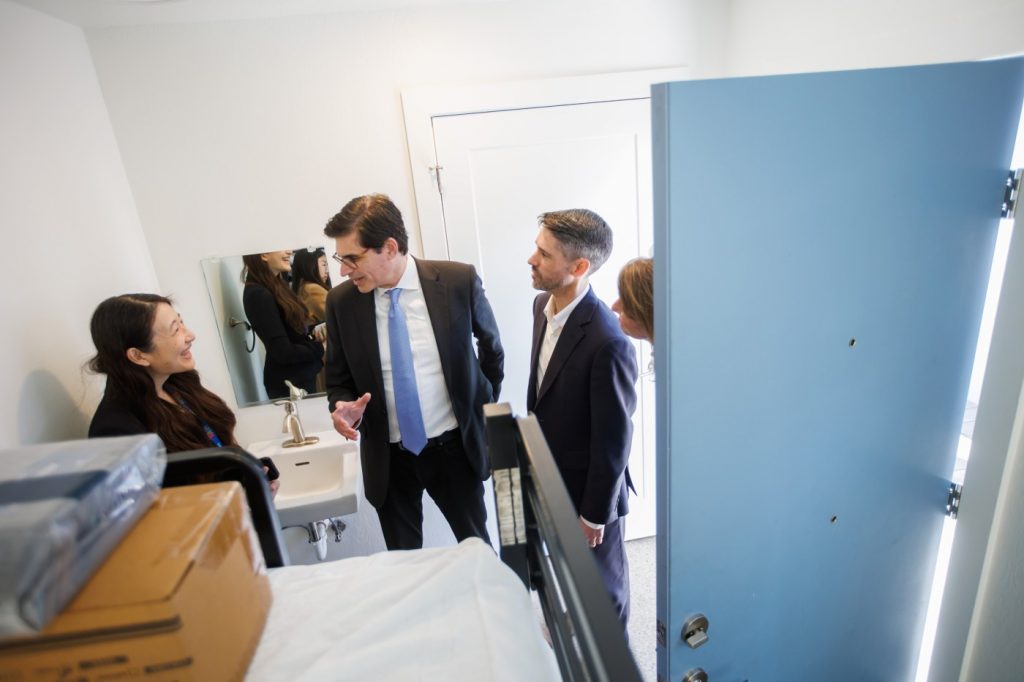California lacks anywhere near enough homeless shelters for everyone living on the street. To bring more people indoors and out of harm’s way, Bay Area lawmakers are pushing a new bill to fast-track building tiny homes and other kinds of temporary shelter statewide.
“People are dying on our streets every day,” said State Sen. Josh Becker, a Democrat from Menlo Park, while unveiling the legislation Monday at a recently completed shelter in San Jose.
The proposal reflects a growing shift in how some officials say the state and local governments should respond to homelessness, as communities grow increasingly frustrated over encampments and jarring scenes of human suffering in public view despite billions of dollars spent to stem the crisis.
Instead of focusing on adding permanent affordable housing that offers a direct route out of homelessness, these officials and service providers argue scaling up shelter options is a far quicker and more cost-effective way to help unhoused people get the care they desperately need.
“Historically, the message we’ve heard at the federal level all the way down has been deeply entrenched that permanent housing is the only valid use of taxpayer funds,” said Elizabeth Funk, chief executive of Dignity Moves, which operates tiny home shelters across the Bay Area.
Estimates show California had roughly 181,000 homeless residents last year, a 6% increase from 2022. About seven in 10 lived outdoors, in vehicles or other places not meant for habitation — the largest share of any state in the country.
Thad Kousser, a political science professor at UC San Diego, said the public is demanding new strategies to get people off the street. But he said whether the bill lives or dies hinges on how local neighborhoods, as well as developers and homeless service providers who build and operate shelters or housing, respond to the proposal.
“The question is, whose interest does it hurt?” Kousser said. “We want more homeless shelters, but not in my backyard. We want more homeless shelters, but does it come at the expense of affordable housing?”
Senate Bill 1395 aims to cut red tape by rolling back environmental reviews and local zoning restrictions for “interim housing” shelter sites with services. Unlike traditional dorm-style group shelters with strict rules and little privacy, interim sites offer residents individual rooms with the aim of providing a more welcoming and stable environment while they receive help finding permanent housing.
The shelters can include tiny homes, cabin shelters or rooms in renovated former motels. The goal is to move residents into long-term housing in a few months, and homeless people can often apply to stay longer on a case-by-case basis.
Brendan Underwood said that moving into the San Jose shelter — made up of shipping containers transformed into private cabins — allowed him to kick drugs and escape the brutal reality of living outdoors, where he said he was pepper-sprayed in his sleep and assaulted multiple times.
“It really is a night and day difference between fighting for your life on the street and actually being able to work toward goals,” he said.
An interior view of Evans Lane, an interim housing site, on Monday, March 4, 2024, in San Jose, Calif. (Dai Sugano/Bay Area News Group)
However, some advocates for homeless people say that while more shelter is needed, it still amounts to only a temporary solution. They argue that without more investment in affordable and supportive housing, many shelter residents will continue struggling to find lasting homes, given the state’s severe affordable housing shortage.
“When you’re in shelter, you’re still counted as being homeless, so you need that permanent destination,” said Ray Bramson, chief operating officer with Destination: Home, a Silicon Valley homelessness solutions nonprofit.
The debate is playing out in San Jose, where officials aim to continue erecting hundreds of new tiny homes and “quick-build” cabin shelters, in part to gain the legal authority to clear more encampments. A city report from last year found that about half of the roughly 900 people who stayed in interim shelters in 2022 moved on to permanent housing.
Last week, at the direction of state regulators, San Jose officials announced they are devising an ambitious plan to move about 1,000 homeless people from its creeks and rivers into shelters. State environmental regulators are threatening fines and litigation should the city fail to clear sensitive waterways by the middle of next year.
Related Articles
Letters: Green space | Harsh choices | Untold rewards | Help homeless | Preserve independence
Health officials working to contain Shigella outbreak in Santa Cruz County
San Jose to clear 1,000 homeless people from creeks and waterways
San Jose slashes price tag of planned largest-ever RV safe parking site
Walters: California spends billions on homelessness yet crisis keeps getting worse
At Monday’s news conference, San Jose Mayor Matt Mahan, who’s expected to sail to reelection on Tuesday, touted the city’s effort to boost shelter space as a model for the new bill. He said it’s the only viable strategy since affordable housing can take years and cost as much as $1 million for a single unit. The San Jose shipping container shelter was built in less than 12 months and cost about $66,000 a door, he said.
“Despite initial resistance, our community has come to embrace this solution,” said Mahan, noting a reduction in crime and blight in neighborhoods where people moved into shelters.
While some residents worry building new shelters will draw more unhoused people from other states or regions, local survey data shows around 70% to 80% of homeless people in the Bay Area live in the same county where they lost their housing.
San Francisco Mayor London Breed also supports the proposed law, calling it in a statement, “a crucial step in helping people get off of the streets and into homes.”
Opening new shelters may cost less than new affordable housing, but keeping them up and running could be expensive in the long run. Earlier this year, San Jose estimated that if it follows through on plans to add about 700 more shelter units, total operational expenses could soon exceed $70 million annually, about twice the current cost.


